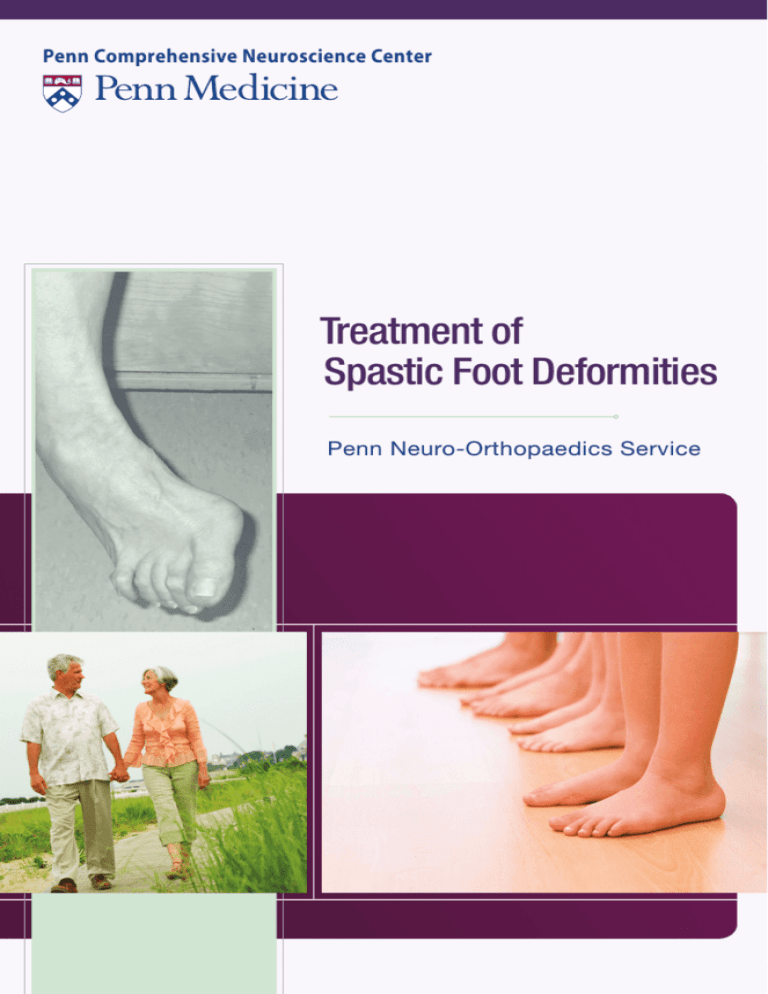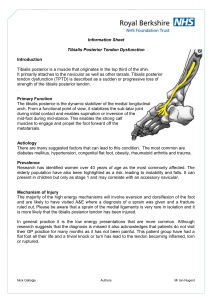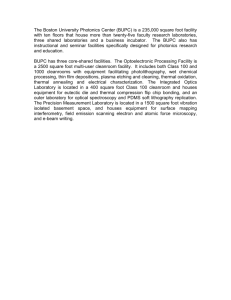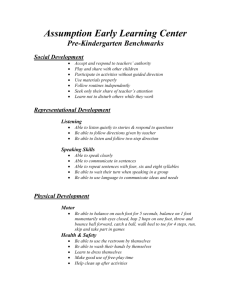
Penn Comprehensive Neuroscience Center
Treatment of
Spastic Foot Deformities
Penn Neuro-Orthopaedics Service
1
Overview
Table of Contents
Overview
Overview
1
Treatment
2
Procedures
4
4
5
6
7
8
9
Achilles Tendon Lengthening
Toe Flexor Releases
Toe Flexor Transfer
Split Anterior Tibialis Tendon Transfer (SPLATT)
The Extensor Tendon of the Big Toe (EHL)
Lengthening the Tibialis Posterior Tendon
Care After Surgery 10
Notes
12
Pre-operative right foot.
Severe loss of movement is often the result of neurological
disorders, such as stroke or brain injury. As a result, ordinary
daily activities such as walking, eating and dressing can be
difficult and sometimes impossible to accomplish.
The Penn Neuro-Orthopaedics Service assists patients with
orthopaedic problems caused by certain neurologic disorders.
Our team successfully treats a wide range of problems affecting
the limbs including foot deformities and walking problems due
to abnormal postures of the foot.
This booklet focuses on the treatment of spastic foot deformities
under the supervision of Mary Ann Keenan, M.D., Director of
the Penn Neuro-Orthopaedic Service and her clinical team. Dr.
Keenan has developed many of the evaluation and surgical
techniques used in reconstructive neuro-orthopaedics and has
published and lectured extensively worldwide.
Post-operative position of the right foot.
1
Treatment
Treatment of Spastic Foot Deformities
The Common Problem
The Common Problem, continued
An injury to the brain or spinal cord often affects the brain’s
control of the muscles in the arms and legs. A condition called
spasticity occurs when the muscles in the leg turn on too early
during walking or overreact to a stretching force. Another
condition, called increased tone, occurs when a muscle has
difficulty relaxing.
Treatment for muscle spasticity with oral medications causes
drowsiness and is not effective. Other treatments, such as
phenol nerve blocks and botulinum toxin (Botox®) muscle
injections, provide only temporary muscle relaxation. Generally
a permanent solution, such as orthopaedic surgery, is needed.
This surgery is helpful in re-balancing the muscle pull and
straightening the foot. The surgery can be done as early as
six months after the onset of the foot deformity and is also
successful when performed many years later.
The foot most commonly develops a deformity called
equinovarus or an adult club foot. This refers to the foot being
in a toe down position (equinus) and also tilted inward (varus).
The toes usually curl painfully in the shoe. The big toe may
pull into an up position when the leg swings during walking, a
condition commonly called a “Hitch Hiker Toe.” It is difficult
to walk with the foot in such an awkward position and painful
to stand on the twisted foot. The abnormal position of the foot
causes poor balance and aggravates other spastic muscles both
in the leg and in the arm.
If the abnormal muscle pull is not
strong, then a short leg brace, called an
ankle foot orthosis (AFO), can control
the position of the foot. Frequently,
the muscle pull is very strong. In this
situation a brace is not sufficient to keep
the foot in a normal position.
Several muscles working in combination cause the foot
deformities. These include the calf and toe flexor muscles
pulling the foot downward. The foot is twisted inward by the
pull of the tibialis anterior muscle and the extensor muscle of
the big toe muscle, located on the front of the leg. Often the
posterior tibialis muscle, located behind the ankle, also adds
to the inward turn of the foot.
Gait Study
Sometimes it is helpful to perform a special test called a gait study.
The test tells the doctors exactly how each muscle is behaving
when a person is walking and gives an indication of the strength
of the muscle pull. Information about walking speed and step
size is also recorded during the test. This information is used to
decide what combination of tendon transfers or lengthenings
will give the best correction of the foot deformity.
An equinovarus foot is common after brain injury or stroke.
It is caused by abnormal activity in several muscles.
3
Procedures
Types of Surgical Procedures
There are several surgical procedures used to correct these
deformities. Most commonly, a combination of tendon
lengthening and transfer is performed.
Achilles Tendon Lengthening
The toe down or equinus deformity of the foot is corrected by
lengthening the calf muscles or Achilles tendon (the heel cord).
A tendon is the structure or leader that connects a muscle to the
bone. Making three small cuts in the tendon through small nicks
in the skin lengthens the Achilles tendon. This allows the tendon
fibers to stretch and brings the foot to a flat position on the floor.
When the foot deformity is less severe, the calf muscles are
lengthened in the calf. This saves more strength in the leg.
Shortened
Achilles Tendon
Toe Flexor Releases
There are two sets of toe flexor muscles: the long muscles and the
short muscles. The short toe muscles are in the arch of the foot. The
long toe flexor muscles are in the calf and attach to the toes by long
tendons that travel behind the ankle and through the foot. The long
toe flexor tendons pull the foot downward into equinus and curl
the toes. The short toe flexor muscles also curl the toes. In most
feet, spasticity in both sets of muscles causes severe toe curling that
is very painful when standing. To correct the toe curling deformity,
both sets of tendons must be released. The tendons of each toe are
released through a very small incision at the base of each toe on the
undersurface of the foot.
Lengthened
Achilles Tendon
Making small nicks in a staggered pattern
on the Achilles tendon allows it to lengthen.
Releasing the tight flexor tendons allows the toes to lie flat.
5
SPLATT
Toe Flexor Transfer
Split Anterior Tibialis Tendon Transfer (SPLATT)
The calf muscles are weak because of the spasticity. The weakness is
made worse by the inability to walk normally and exercise as before
the injury to the brain or spinal cord. Normal walking requires
strong calf muscles. In order to improve the strength of the weak
calf, one of the long toe flexor tendons is transferred to the heel.
Since the long toe flexor muscle resides in the calf, it is very easy
to re-route its tendon into a small tunnel in the heel bone. This
converts it to a calf muscle and significantly strengthens the leg.
When this transfer is done, it is less likely that a person will need to
use a brace for walking after surgery.
The inward twisting of the foot is commonly caused by overactivity in the tibialis anterior muscle. To re-balance the
muscle pull, the tibialis anterior tendon is first split into two
equal halves. One half of the tendon is moved to the outer
side of the foot while the other half is left attached to the inner
side of the foot. Now the muscle pulls equally on both sides of the
foot. This is called a SPLATT operation. SPLATT is an abbreviation
for this transfer.
Flexor tendon of the
toes transferred to
the heel.
Moving the toe flexor tendon to the heel redirects its pull. It becomes
a new calf muscle and increases the strength needed for walking.
Three small incisions are needed for the SPLATT transfer.
The tibialis anterior muscle belly is located on the front of the
leg. The tendon of the muscle attaches to the inner aspect of
the foot. One-half of this tendon is surgically detached while
the other half of the tendon is left in place. The detached half
of the tendon is pulled
upward in the leg under
the skin splitting it into
Tibialis
Anterior
two portions. By pulling
Muscle
the tendon upward to the
second incision the tendon
now takes on a V-shape.
The tendon is then passed
under the skin to the third
incision on the outside of
the foot. This tendon is
attached to a bone on the
outside of the foot through
a small tunnel. The tibialis
anterior muscle now pulls
The SPLATT operation re-balances
the pull of the tibialis anterior
evenly on both the inside
muscle and holds the foot straight.
and outside of the foot.
7
Procedures
The Extensor Tendon of the Big Toe (EHL)
Lengthening of the Tibialis Posterior Tendon
If the extensor muscle of the big toe is spastic, it causes a
hitchhiker toe deformity in which the big toe points upward.
This also causes the foot to turn inward into a varus position.
The big toe often hits the top of the shoe causing a callus or sore.
Transfer of the big toe extensor muscle to the center of the top
of the foot will correct this problem. This enables the extensor
muscle to help pull the entire foot upward and prevent the toes
from dragging on the floor. Transfer of the big toe extensor
muscle requires only a small incision of the top of the foot.
If the tibialis posterior muscle has abnormal activity, it also
pulls the foot inward. This pull is most commonly seen with
the heel turning inward. This muscle can easily be lengthened at
the point where the muscle and tendon connect, located on the
inner aspect of the leg. The tibialis posterior muscle lies directly
next to the long toe flexor muscles. If it needs to be lengthened,
it is done through the same incision as the toe flexor transfer.
Tibialis Posterior
tendon has been
lengthened
Extensor
tendon of
the big toe is
transferred to
the center of
the foot
Normal position of the
big toe extensor tendon
The tendon has
been transferred.
The tibialis posterior tendon is lengthened
through a small incision on the inside of the leg.
9
Care After Surgery
Care After Surgery
After surgery, it is important to hold the foot in a natural position
until all of the tendons have healed. It takes a total of three
months for tendons to heal to the bone in their new position.
First, a short-leg walking cast is applied in the operating room,
allowing the person to walk on the foot with full weight while
in this cast. It is important not to allow the cast to get wet.
Heavy plastic cast covers are available from medical supply
stores. These provide a waterproof seal and will allow a person
to shower while wearing the cast. Plastic garbage bags should
not be used to protect the cast from water because they are
made of thin plastic and will leak. If the cast gets wet, it must
be changed promptly since wet bandages can cause skin sores
and infection.
Approximately two weeks after surgery, the cast is removed,
the bandages are changed and the healing of the incisions is
checked. A new short leg walking cast is applied.
Six weeks after surgery, the foot is then held in a short-leg brace.
The brace is used to hold the foot in a neutral position for an
additional six weeks. Commonly, a short plastic brace is used
which fits inside of the shoe. It is necessary to have a shoe that is
at least one size larger than the person’s normal shoe so that the
brace can fit comfortably. The brace is worn continuously, even
while sleeping, for another six weeks to allow further healing
and strengthening of the tendons.
Swelling in the foot is very common after surgery, but it is a
temporary problem. Frequent elevation of the foot above the
heart best treats the swelling. When wearing the brace, an elastic
support stocking is also very useful.
Three months after surgery, it is possible to begin walking without
the brace. The brace must be discontinued slowly to allow the
muscles to become stronger. It is important to walk and exercise
the foot regularly to regain the strength in the muscles.
At first, the patient is allowed to walk without a brace for ten minutes,
three or four times a day. As the leg gets stronger the amount of
time without the brace is slowly increased. Approximately 70%
of people who have these
operations are eventually
able to walk comfortably
and safely without a brace.
Those who still need a brace
will wear a lightweight and
generally flexible plastic
brace and are able to walk
better and have improved
balance.
A plastic short leg brace,
sometimes referred to as a MAFO
11
Notes
About The Penn
Neuro-Orthopaedics Service
© 2009 by the University of Pennsylvania. All rights reserved. No part of this publication may be reproduced without permission.
The Penn Neuro-Othopaedics Service, part of the Penn
Comprehensive Neuroscience Center and Penn Orthopaedics,
offers the latest advances in diagnosis and treatment to patients
whose arms or legs are impaired by brain injury, stroke, central
nervous disorders or orthopaedic conditions. We focus on
recovering lost function, regaining mobility and improving
performance in persons with permanent disability or chronic
neurologic disease.
Our service is appropriate for patients with orthopaedic problems
caused by brain injury, cerebral palsy, Charcot-Marie Tooth
disease, multiple sclerosis, polio, spinal cord injury and stroke.
In addition to treating foot deformities and walking problems related
to the foot, we successfully treat clenched-fist and thumb-in-palm
deformity, flexed elbow deformity, heterotopic bone growth, hip
and knee contractures, scissoring gait and stiff shoulder.
Information and Appointments
For more information or to schedule an appointment,
call 800.789.PENN (7366) or visit PennMedicine.org.
PENN Medicine, a non-profit organization,
is a world-renowned institution dedicated
to discoveries that will advance patient care
throughout the world and to the education of
physicians and scientists of tomorrow to carry on
the legacy of excellence. Through your generous
support, we can continue our mission to further
medical excellence through research, patient
care and education. To support PENN Medicine
by making a gift, please visit PennMedicine.org/
giving or contact us at 215.898.8094.
Location
Hospital of the
University of Pennsylvania
3400 Spruce Street
2 Silverstein
Philadelphia, PA 19104








